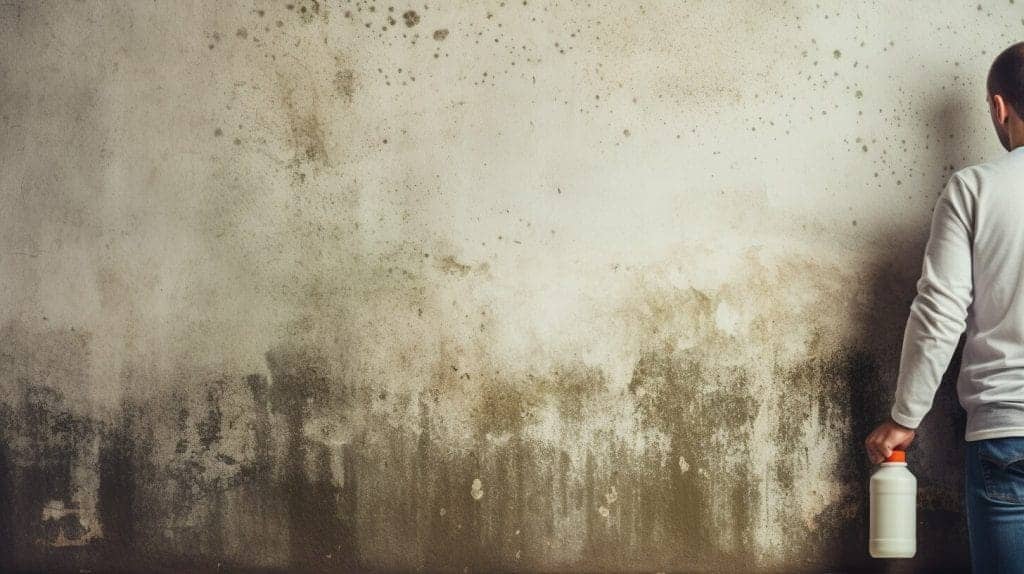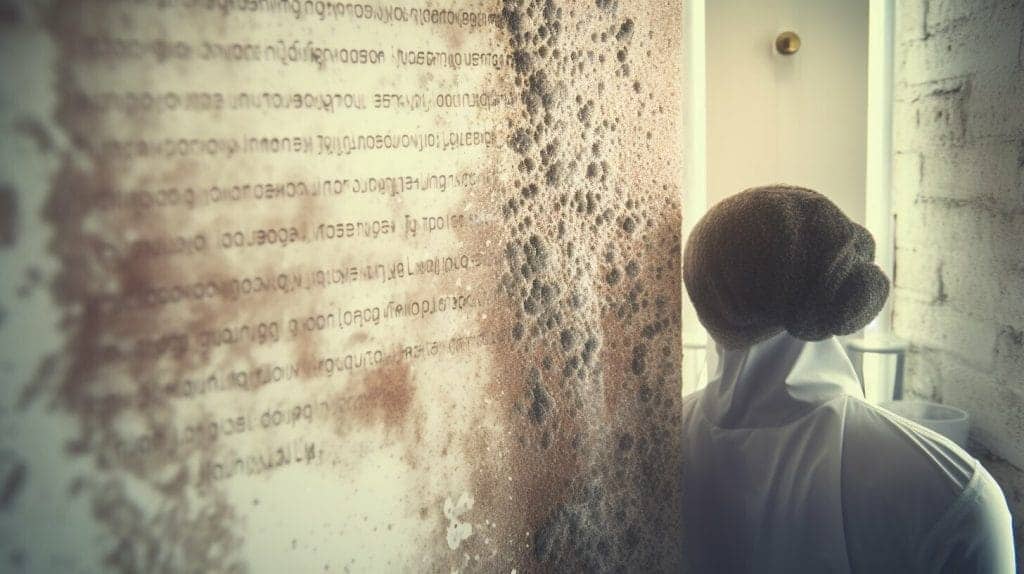Are you experiencing flu-like symptoms that don’t seem to go away? You may want to consider whether toxic mold could be the culprit. Toxic mold is a type of mold that can release harmful toxins into the environment, leading to adverse health effects.
Symptoms of mold exposure can include coughing, sneezing, headaches, and fatigue, which can easily be mistaken for the flu. It’s important to identify whether toxic mold is the cause of these symptoms to receive proper treatment and prevent further exposure.
What is Toxic Mold and Where is it Found?
Toxic mold, also known as black mold or Stachybotrys chartarum, is a type of mold that produces mycotoxins, which can cause adverse health effects in humans. Toxic mold is commonly found in areas with high humidity, moisture, and poor ventilation, such as bathrooms, kitchens, and basements. It can grow on surfaces such as wood, paper, and drywall, and may also be found in HVAC systems and air ducts.
Exposure to toxic mold can cause a range of symptoms, including respiratory problems, headaches, dizziness, fatigue, and flu-like symptoms. Individuals with compromised immune systems, respiratory issues, or allergies may be more susceptible to the adverse effects of toxic mold exposure.
| Types of Toxic Mold | Description |
|---|---|
| Stachybotrys Chartarum | A greenish-black mold commonly found on cellulose materials such as paper, wood, and cardboard. |
| Aspergillus | A type of mold commonly found in soil, water, and decaying vegetation. It may also grow on food and in air conditioning systems. |
| Penicillium | A blue or green mold commonly found in water-damaged buildings and on food items. |
If you suspect that your home or workplace has toxic mold, it is important to address the issue promptly. This may involve contacting a professional mold remediation company to assess the extent of the mold growth and develop a plan for removal. Preventing moisture buildup and addressing water damage promptly can also help prevent mold growth in the future.
How Does Toxic Mold Affect Your Health?
Toxic mold exposure can have a variety of health effects, depending on the individual and the extent of exposure. While some people may experience mild symptoms, others may develop more severe respiratory problems or even mold-related illness.
| Type of Health Effect | Explanation |
|---|---|
| Respiratory problems | Exposure to toxic mold can cause respiratory problems such as coughing, wheezing, and shortness of breath. Individuals with asthma or other respiratory conditions may experience exacerbated symptoms when exposed to toxic mold. |
| Mold illness | Mold illness is a term used to describe a range of symptoms that can occur when individuals are exposed to toxic mold. These symptoms can include fatigue, headache, fever, joint pain, and even neurological symptoms such as memory loss or confusion. |
| Other adverse reactions | In some cases, toxic mold exposure can cause other adverse reactions such as skin irritation, eye irritation, and digestive problems. |
It’s important to note that the severity of symptoms can vary depending on several factors, including the type of mold, the extent of exposure, and the individual’s overall health. If you suspect toxic mold exposure, it’s important to seek medical attention to properly diagnose and treat any health issues that may arise.
How Do You Identify Toxic Mold in Your Home?
If you suspect that you have been exposed to toxic mold, it is important to identify and address the problem as soon as possible. Here are some tips on how to identify toxic mold in your home:
- Look for visible signs of mold growth, such as black, green, or white spots on walls, ceilings, or floors
- Use your nose to detect any musty or earthy odors
- Check for water damage or moisture problems in your home, such as leaky pipes, roof leaks, or condensation on windows or walls
- Pay attention to any respiratory symptoms you may be experiencing, such as coughing, sneezing, or wheezing, which are common signs of mold exposure
If you suspect that you have toxic mold in your home, it is important to take action to address the problem. Ignoring the issue can lead to serious health problems and expensive repairs down the line.
Note: If you are unsure whether the mold in your home is toxic or not, it is best to err on the side of caution and treat it as toxic mold. This will help prevent any adverse health effects from exposure.
What Are the Health Risks of Long-Term Mold Exposure?
Long-term exposure to toxic mold can have severe health consequences. The following are some of the most significant health risks:
-
Mold illness: Prolonged mold exposure can cause mold illness, which can lead to a wide range of symptoms such as fatigue, headache, memory loss, and cognitive impairment.
-
Respiratory problems: Toxic mold exposure can cause or worsen respiratory problems such as asthma, bronchitis, and sinusitis. It can also lead to coughing, wheezing, and shortness of breath.
-
Neurological symptoms: Exposure to toxic mold can cause neurological symptoms such as tremors, seizures, and confusion.
-
Immune system disorders: Mold exposure can weaken the immune system, making individuals more susceptible to infections and illnesses.
-
Cancer: Long-term exposure to toxic black mold has been associated with an increased risk of cancer.
If you suspect that you have been exposed to toxic mold for an extended period, it is essential to seek medical attention immediately. Identifying and addressing the underlying cause of exposure is crucial to preventing further health complications.
How to Prevent Mold Growth in Your Home?
Mold growth is a common problem in many households, and it can cause various health issues such as allergic reactions, respiratory problems, and mold-related illness. The good news is that you can prevent mold growth in your home by following some simple steps.
Maintain Proper Moisture Levels
Moisture is the primary cause of mold growth. Therefore, it is essential to maintain proper moisture levels in your home. Fix any leaks or water damage immediately, keep humidity levels below 60%, and ensure proper ventilation in areas prone to moisture, such as bathrooms and kitchens. Proper ventilation will help prevent the buildup of excess moisture.
Address Any Water Damage Promptly
If you experience water damage in your home, you must address it immediately to prevent mold growth. Dry out the affected area within 24 to 48 hours, and if necessary, use a dehumidifier to remove any excess moisture.
Clean and Dry Your Home Regularly
Regular cleaning and drying of your home can prevent the buildup of mold. Ensure that the surfaces in your home are clean and dry to prevent any moisture from being absorbed and mold growth. Use a disinfectant or mold-specific cleaner to clean any areas that may harbor mold and ensure that they are adequately dried.
Use Mold-Resistant Products
You can also use mold-resistant products in your home to prevent mold growth. These include mold-resistant drywall, paint, and insulation. When renovating or building your home, use these mold-resistant products to help prevent mold growth.
Monitor Your Home for Signs of Mold Growth
Monitor your home regularly for signs of mold growth, such as a musty odor, visible mold, or respiratory symptoms. If you identify any signs of mold growth, address it promptly to prevent further growth and potential health risks.
Following these simple steps can help prevent mold growth in your home and protect you and your family from any adverse health effects of toxic mold exposure.
What Should You Do if You Suspect Mold Exposure?
If you suspect that you or your family have been exposed to toxic mold, it is important to take action promptly. Here are some steps you can take:
- Seek medical attention if you are experiencing any mold exposure symptoms, such as respiratory problems, allergic reactions, or flu-like symptoms. Be sure to tell your healthcare provider about your suspicions of mold exposure.
- Identify the source of the mold and address it promptly to prevent further exposure. This may involve hiring a professional to inspect and remove the mold from your home.
- If the mold growth is extensive or you have underlying health issues, consider temporarily relocating until the mold is removed and the air quality is improved.
- Take steps to prevent mold growth in the future by addressing any moisture issues in your home, improving ventilation, and ensuring proper humidity levels.
It is important to note that mold exposure can have serious health effects, so it is crucial to take action if you suspect mold growth in your home or workplace. By taking the proper steps, you can protect yourself and your loved ones from the adverse effects of toxic mold exposure.
Can You Test for Mold in Your Home?
If you suspect that your home has toxic mold, it is important to get it tested as soon as possible to prevent adverse health effects. There are several methods of mold testing that can be used to detect mold in your home.
Home Testing Kits
Home testing kits are readily available in most hardware stores and can be relatively inexpensive. These kits contain a small dish and a petri dish to collect the mold samples, as well as a medium to grow the mold over time. Some kits also include a visual comparison chart to identify the type of mold.
| Pros of Home Testing Kits | Cons of Home Testing Kits |
|---|---|
| – Affordable | – Results may not be accurate |
| – Easy to use | – Limited ability to identify specific types of mold |
Air Sampling
Air sampling involves collecting samples of the air in your home to detect the presence of mold spores. This method can be more accurate than home testing kits, but it requires specialized equipment and should be performed by a professional.
| Pros of Air Sampling | Cons of Air Sampling |
|---|---|
| – More accurate results | – Can be more expensive than home testing kits |
| – Identifies specific types of mold | – Requires specialized equipment and professional assistance |
It is important to note that mold testing should always be accompanied by a thorough visual inspection of your home, as mold may not always be visible. If you suspect that you have mold in your home, it is best to seek professional assistance to ensure accurate identification and safe removal.
What Are the Best Ways to Remove Mold from Your Home?
If you have identified mold growth in your home, it is essential to remove it promptly to prevent adverse health effects. Here are some of the best ways to remove mold from your home:
| Method | Description |
|---|---|
| Bleach solution | A solution of one cup of bleach in one gallon of water can effectively kill mold on non-porous surfaces. |
| Vinegar | White vinegar can be used to clean and remove mold on non-porous surfaces. |
| Baking soda | A mixture of baking soda and water can be used to remove mold on non-porous surfaces. |
| Hydrogen peroxide | Hydrogen peroxide can be used to remove mold on non-porous surfaces and is a safer alternative to bleach. |
For porous surfaces, such as drywall and carpet, it is often best to replace the affected area to ensure complete removal. Additionally, it is crucial to identify and address the underlying cause of the mold growth, such as water damage, to prevent future growth.
It is essential to take precautions when removing mold, including wearing protective gear such as gloves, a mask, and eye protection. If the mold growth is extensive, it may be necessary to hire a professional mold remediation service to ensure proper removal and prevent contamination.
Frequently Asked Questions (FAQs) About Toxic Mold and Flu-Like Symptoms
Q: Can toxic mold cause flu-like symptoms?
Yes, exposure to toxic mold can cause flu-like symptoms, such as coughing, sneezing, headaches, and fever. If you suspect toxic mold exposure, seek medical attention immediately.
Q: What is the difference between mold illness and other respiratory problems caused by mold exposure?
Mold illness, also known as toxic mold syndrome, is a condition caused by exposure to high levels of toxic mold. It can cause a wide range of symptoms, including fatigue, muscle weakness, joint pain, and memory problems. Other respiratory problems caused by mold exposure, such as asthma and allergies, are usually caused by exposure to non-toxic mold.
Q: What are the long-term health effects of toxic mold exposure?
Long-term exposure to toxic mold can cause serious health problems, including respiratory problems, neurological disorders, and immune system dysfunction. It can also increase the risk of developing certain types of cancer.
Q: Can mold spores cause flu-like symptoms even if there is no visible mold growth?
Yes, mold spores can cause flu-like symptoms even if there is no visible mold growth. Mold spores can be present in the air and can cause allergic reactions and respiratory problems. It’s important to address any symptoms of mold exposure promptly, even if there is no visible mold growth.
Q: How can I prevent mold growth in my home?
To prevent mold growth in your home, you should maintain proper moisture levels, ensure proper ventilation, and address any water damage promptly. Additionally, you should monitor humidity levels and use a dehumidifier if necessary. Regularly cleaning and maintaining your HVAC system can also help prevent mold growth.
Q: How can I test for mold in my home?
There are several methods for testing for mold in your home, including air testing, surface testing, and bulk testing. It’s important to hire a professional to perform the testing to ensure accurate results. If you suspect mold exposure, seek medical attention immediately.
Q: What are the best ways to remove mold from my home?
The best way to remove mold from your home depends on the type and extent of the mold growth. In general, you should wear protective gear and use appropriate cleaning products and techniques. If the mold growth is extensive, it may be necessary to hire a professional mold remediation company. It’s important to address mold growth promptly to prevent adverse health effects.
Conclusion
In conclusion, it is essential to identify and address toxic mold exposure promptly to prevent adverse health effects. This includes understanding what toxic mold is, where it can be found, and the common symptoms associated with mold exposure.
If you suspect mold exposure, seek medical attention and take steps to prevent further exposure. This includes identifying and addressing mold growth in your home and maintaining proper moisture levels to prevent future growth.
Additionally, it is crucial to understand the long-term health risks associated with mold exposure, including respiratory problems and mold-related illness. Accurate mold testing and removal techniques are essential in addressing these health concerns.
Frequently Asked Questions (FAQs) About Toxic Mold and Flu-Like Symptoms
Q: Can mold spores cause flu-like symptoms?
A: Yes, exposure to toxic mold can cause flu-like symptoms, including coughing, sneezing, and fever.
Q: What is mold illness?
A: Mold illness is a type of illness caused by exposure to toxic mold, resulting in a range of symptoms and health effects.
Q: What are the long-term health effects of toxic mold exposure?
A: Long-term health effects of toxic mold exposure can include respiratory problems, mold-related illness, and other adverse health effects.
Q: How can I remove mold from my home?
A: The best way to remove mold from your home depends on the type and extent of the growth. It is important to take proper precautions and use appropriate methods to prevent further exposure.
Q: What should I do if I suspect mold exposure?
A: If you suspect mold exposure, seek medical attention, address the underlying cause, and take steps to prevent further exposure.
Dr. Francisco Contreras, MD is a renowned integrative medical physician with over 20 years of dedicated experience in the field of integrative medicine. As the Medical Director of the Oasis of Hope Hospital in Tijuana, Mexico, he has pioneered innovative treatments and integrative approaches that have been recognized globally for the treatment of cancer, Lyme Disease, Mold Toxicity, and chronic disease using alternative treatment modalities. Dr. Contreras holds a medical degree from the Autonomous University of Mexico in Toluca, and speciality in surgical oncology from the University of Vienna in Austria.
Under his visionary leadership, the Oasis of Hope Hospital has emerged as a leading institution, renowned for its innovative treatments and patient-centric approach for treating cancer, Lyme Disease, Mold Toxicity, Long-Haul COVID, and chronic disease. The hospital, under Dr. Contreras's guidance, has successfully treated thousands of patients, many of whom traveled from different parts of the world, seeking the unique and compassionate care the institution offers.
Dr. Contreras has contributed to numerous research papers, articles, and medical journals, solidifying his expertise in the realm of integrative medicine. His commitment to patient care and evidence-based treatments has earned him a reputation for trustworthiness and excellence. Dr. Contreras is frequently invited to speak at international conferences and has been featured on CNN, WMAR2 News, KGUN9 News, Tyent USA, and various others for his groundbreaking work. His dedication to the medical community and his patients is unwavering, making him a leading authority in the field.
Contreras has authored and co-authored several books concerning integrative therapy, cancer, Lyme Disease and heart disease prevention and chronic illness, including "The Art Science of Undermining Cancer", "The Art & Science of Undermining Cancer: Strategies to Slow, Control, Reverse", "Look Younger, Live Longer: 10 Steps to Reverse Aging and Live a Vibrant Life", "The Coming Cancer Cure Your Guide to effective alternative, conventional and integrative therapies", "Hope Medicine & Healing", "Health in the 21st Century: Will Doctors Survive?", "Healthy Heart: An alternative guide to a healthy heart", “The Hope of Living Cancer Free”, “Hope Of Living Long And Well: 10 Steps to look younger, feel better, live longer” “Fighting Cancer 20 Different Ways”, "50 Critical Cancer Answers: Your Personal Battle Plan for Beating Cancer", "To Beat . . . Or Not to Beat?", and “Dismantling Cancer.”









